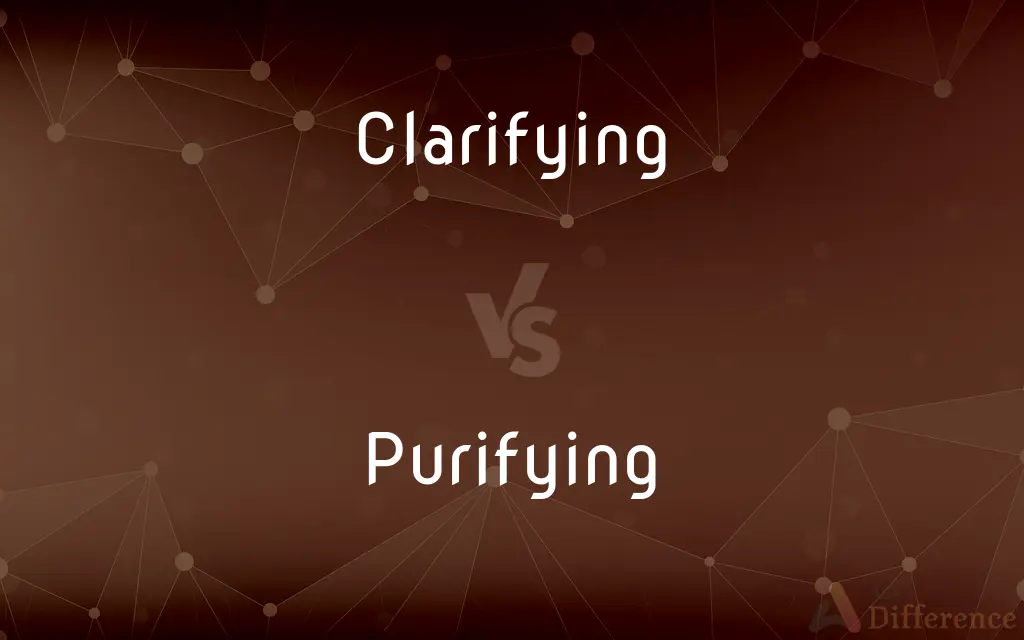Clarifying vs. Purifying — What's the Difference?
Edited by Tayyaba Rehman — By Urooj Arif — Updated on April 7, 2024
Clarifying removes particles and impurities for transparency, while purifying eliminates contaminants for purity.

Difference Between Clarifying and Purifying
Table of Contents
ADVERTISEMENT
Key Differences
Clarifying is primarily about enhancing the clarity of a substance by removing suspended particles that cloud its appearance. This process is vital in industries such as food and beverage, where visual quality is as important as taste. For example, clarifying beer or juice involves filtering out yeast and other particulates to achieve a clear, appealing drink. On the other hand, purifying goes a step further by aiming to remove not just physical impurities, but also chemical and biological contaminants. This is crucial in contexts like water treatment, where the goal is to make water safe for drinking by eliminating pathogens, toxins, and chemical pollutants.
While clarifying improves a product's aesthetic appeal by making it more transparent and visually pleasing, purifying focuses on making a substance safe for consumption or use. Purifying water, for instance, may involve processes such as reverse osmosis, distillation, or chemical treatment to ensure it is free from harmful substances. Clarifying, in contrast, might simply involve passing the water through a fine filter to remove turbidity without necessarily making it safer to drink.
In the context of skincare, clarifying products aim to clear the skin's surface of dead cells and debris, improving texture and luminosity. These products might include toners or exfoliants that help to refine the skin’s appearance. Purifying skincare products, however, target deeper issues like bacteria and toxins, often featuring ingredients like charcoal or clay to absorb impurities and cleanse the pores.
The tools and methods used in clarifying and purifying can also differ. Clarifying often relies on physical filtration or sedimentation techniques, whereas purifying may incorporate a broader range of methods, including biological treatments, chemical additives, and advanced filtration technologies to achieve a higher level of cleanliness and safety.
Both clarifying and purifying play essential roles in various industries and applications, but they serve different purposes. Clarifying is about improving visual clarity and quality, while purifying is concerned with removing a wide range of contaminants to ensure the purity and safety of a substance.
ADVERTISEMENT
Comparison Chart
Goal
Enhance clarity and remove cloudiness
Remove contaminants for purity and safety
Primary Focus
Aesthetic appearance
Safety and cleanliness
Common Applications
Food and beverage, skincare
Water treatment, air purification, skincare
Example Processes
Filtration, sedimentation
Reverse osmosis, distillation, chemical treatment
Example Products
Juices, beers, facial toners
Purified water, air purifiers, detoxifying masks
Compare with Definitions
Clarifying
Making a statement or situation less ambiguous.
The official press release was clarifying the government's stance.
Purifying
Refining a substance to remove impurities.
Purifying metals is essential for achieving high-quality materials.
Clarifying
Making something less confused and more clearly comprehensible.
The teacher's explanation was clarifying the complex topic.
Purifying
Removing contaminants from something to make it pure.
Purifying water in remote areas can be challenging.
Clarifying
Removing unwanted solid matter from a liquid to improve clarity.
Clarifying wine can be done using a variety of fining agents.
Purifying
The process of making something spiritually or morally clean.
The ritual was purifying the space of negative energies.
Clarifying
The process of making a liquid clear by filtering out impurities.
Clarifying the broth involves skimming off the fat.
Purifying
Clearing a substance of unwanted chemicals or biological contaminants.
The new filter is capable of purifying air at a higher efficiency.
Clarifying
Intended to cleanse or refine a surface.
The clarifying shampoo removed all the buildup from my hair.
Purifying
Cleansing something to make it safe and clean.
The skincare routine involved purifying the skin deeply every night.
Clarifying
To make clear or easier to understand; elucidate
Clarified her intentions.
Purifying
To rid of impurities
Purify water.
Clarifying
To clear of confusion or uncertainty
Clarify the mind.
Purifying
To rid of foreign or objectionable elements
Tried to purify the party of its dissenters.
Clarifying
To make clear by removing impurities or solid matter, as by heating gently or filtering
Clarify butter.
Purifying
To free from moral or spiritual defilement
Rituals to purify the soul.
Clarifying
To become clear.
Purifying
Present participle of purify
Clarifying
Present participle of clarify
Purifying
An act of purification.
These ritual purifyings have taken place for thousands of years.
Clarifying
A clarification.
Purifying
Serving to purge or rid of sin;
Purgatorial rites
Clarifying
Providing clarity; making clear.
The witness gave some clarifying information about the event.
Purifying
Freeing from noxious matter;
Filtration is a purifying agent
Clarifying
Removing impurities or particulates.
Wash your hair with clarifying shampoo.
Purifying
Acting like an antiseptic
Clarifying
That makes clear;
A clarifying example
Common Curiosities
What does purifying aim to achieve?
To eliminate contaminants for safety and purity, focusing on cleanliness.
Is purifying necessary for drinking water?
Yes, to ensure the water is free from pathogens, toxins, and chemical pollutants.
What is a common example of a clarifying agent?
Fining agents in wine or beer that help to remove particulates.
What is the main goal of clarifying?
To enhance clarity and remove cloudiness, improving the visual quality.
Can clarifying make a substance safe to consume?
Not necessarily, as it focuses on appearance rather than removing all harmful contaminants.
Are clarifying and purifying exclusive to liquids?
No, these processes can apply to air, solids, and even abstract concepts like information.
Do clarifying and purifying use the same methods?
They can overlap, but purifying often involves more advanced or varied techniques.
Why is clarifying important in skincare?
It helps to remove dead skin cells and debris, improving the skin's texture and appearance.
Can a process be both clarifying and purifying?
Yes, some processes aim to both improve clarity and remove contaminants, depending on the context.
How does purifying differ in skincare?
Purifying targets deeper issues, cleansing pores of bacteria and toxins.
Can you purify something without clarifying it?
Yes, purification focuses on safety and cleanliness, which doesn't always require clarity.
Why is purifying air important?
To remove pollutants and contaminants, ensuring the air is healthy to breathe.
Do all purifying methods eliminate viruses?
Not all, but specific methods like UV purification are designed to inactivate or remove viruses.
What is an example of a purifying technology?
Reverse osmosis systems used in water purification.
Is filtration considered clarifying or purifying?
Filtration can be part of both, depending on the filter's specificity and purpose.
Share Your Discovery

Previous Comparison
JIT vs. Lean
Next Comparison
Love vs. LoyaltyAuthor Spotlight
Written by
Urooj ArifUrooj is a skilled content writer at Ask Difference, known for her exceptional ability to simplify complex topics into engaging and informative content. With a passion for research and a flair for clear, concise writing, she consistently delivers articles that resonate with our diverse audience.
Edited by
Tayyaba RehmanTayyaba Rehman is a distinguished writer, currently serving as a primary contributor to askdifference.com. As a researcher in semantics and etymology, Tayyaba's passion for the complexity of languages and their distinctions has found a perfect home on the platform. Tayyaba delves into the intricacies of language, distinguishing between commonly confused words and phrases, thereby providing clarity for readers worldwide.
















































